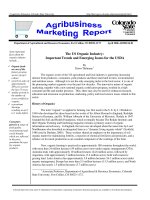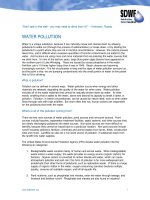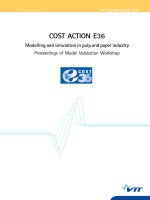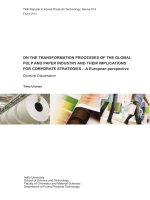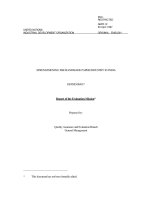BAMBOO AS A NEW FIBER SOURCE IN THE US PAPER INDUSTRY: A FEASIBILITY ANALYSIS FOR BOOSHOOT GARDENS, LLC docx
Bạn đang xem bản rút gọn của tài liệu. Xem và tải ngay bản đầy đủ của tài liệu tại đây (2.66 MB, 84 trang )
BAMBOO
AS
A NEW
FIBER
SOURCE
IN THE
US
PAPER
INDUSTRY:
A FEASIBILITY ANALYSIS
FOR
BOOSHOOT GARDENS,
LLC
BY
EMMA
KALLAWAY
A
THESIS
Presented
to
the
University
of
Oregon
Lundquist
College
of
Business
And
the
Robert
D.
Clark
Honors
College
In
partial
fulfillment
of
the
requirements
for
the
degree
of
Bachelor
of
Science
November
16
th
,
2010
An Abstract
of
the
Thesis
of
Emma Diane Rosemary Kallaway
for
the
degree
of
Bachelor
of
Science
In
the
Lundquist College
of
Business
to
be taken on November 16
th
, 2010
Title: BAMBOO
AS
A
NEW
FIBER
SOURCE
IN
THE
U.S
PAPER
INDUSTRY:
A
FEASIBLITY
ANALYSIS
FOR
BOOSHOOT
GARDENS,
LLC.
Approved: _
Senior
Instructor
Anne
Forrestel
There
is
opportunity
for
Booshoot Gardens,
LLC
to
become a supplier in
the
U.S
paper
industry, build revenue, and secure
future
growth.
This study
is
a feasibility analysis seeking
to
answer
two
questions:
Can
bamboo be used
as
a replacement
fiber
source
for
paper products,
and do market conditions
offer
potential
for
a
new
supplier
to
enter
the
industry? Research
came
from
working
with
scientists in paper engineering,
as
well
as
industry research
to
uncover
the
potential
for
a
new
supplier in
the
U.S
paper industry. Booshoot
staff
agrees
that
in
order
to
succeed in
the
paper industry
the
company
must
supply full grown, chipped bamboo
to
manufacturers in
the
sanitary paper industry, a small niche in
the
larger
U.S
paper industry.
Based on this research Booshoot Gardens,
LLC
has
already begun
to
find investors and expand
the
business
into
the
U.S
Paper Industry.
,.
ACKNOWLEDG
EM
ENTS
My
thesis
for
the Robert
D.
Clark Honors College
has
been the cornerstone
of
my
education
at
the
University
of
Oregon. I would first like
to
thank my primary advisor Anne
Forrestel
for
giving
of
her
time
and constructive criticism which
has
made me a
better
writer,
a
better
student, and a stronger woman. Anne Forrestel
has
been a generous advisor
who
helped
me through a very challenging project. I would also like
to
thank Professor Dayo Mitchell
who
has
been a very supportive advisor
from
the Clark Honors College. From my first day in
the
Clark
Honors College
to
my thesis defense Professor Mitchell
has
worked
with
me
to
succeed.
Instructor Charles Kalnbach
has
also given
of
his time
as
my second reader.
Outside
of
the University
of
Oregon I would like
to
thank Phil Ferranto, GenerallVlanager
at Booshoot Gardens who worked
with
me
to
meet
the
needs
of
Booshoot Gardens. I would
also like
to
thank Professor
Mark
Lewis
from
the University
of
Washington
who
taught me
how
paper
is
made and
what
alternative fibers
can
be
used
to
make paper.
Last
but
not
least, I
would like
to
thank my family
for
giving me unconditional support and many editing hours.
With
all this support I
was
able
to
develop constructive recommendations
for
Booshoot
Gardens which the company
has
already begun
to
implement. Thank you
to
everyone
who
aided in my growth
as
a student and
as
a professional.
1
TABLE
OF
CONTENTS
Critical Introduction 2
What
is
Management Consulting? 7
Consultant Client Relationship 9
Change Models 12
Bigger Isn't Always Better 15
Game Change Strategies 18
The Research Process 20
Feasibility Study 25
Executive Summary 26
Company Overview 29
SWOT
30
Basic
Paper Making Process 33
History
of
the
Paper Industry 34
Industrial Pulping Process 37
Industrial Paper Making Process 40
U.S
Paper Industry 43
Bamboo in Paper Production 48
Industry Analysis
52
Recommendations 65
Ideal Partners in
the
Industry 67
Next Steps 70
Conclusion 71
Appendix A 72
Bibliography 78
2
Critical Introduction: The Theory
of
Consulting
Work
As
a student in the Lundquist College
of
Business, I filled my course load
with
consulting and entrepreneurship classes. I am fascinated by research and decision
making processes
that
can
determine acompany's
success
or
failure.
It
was these
interests which directed me
to
analyze
the
successful new venture Booshoot Gardens,
develop a feasibility study
for
bamboo
as
a raw material in the
u.s
paper industry, and
finally produce my Clark Honors College thesis.
This thesis
has
multiple components. The first
is
a critical introduction which
covers the theory
of
consulting
work
that
shaped
my
interactions
with
Booshoot
as
I
worked
as
a consultant. The second half
is
the
feasibility study
which'
presented
to
Booshoot Gardens on September 28
th
, 2010. This study included research on paper
making, the history
of
the paper industry, the modern paper making process, and where
bamboo can succeed. This necessary background allowed me
to
understand where
Booshoot and bamboo fiber fits
into
the paper industry supply chain. I
then
combined a
number
of
industry analyses
to
make recommendations based on current market
conditions.
My
recommendations and next steps
for
Booshoot come
from
the
building
blocks I discussed above and months
of
research. I am privileged
to
have had the
opportunity
to
pursue my understanding
of
how new ventures succeed.
Most
of
alii
am
pleased
to
share
what
I learned about
the
untapped potential
to
farm bamboo
for
a
more sustainable paper source in
the
United States.
3
Booshoot Gardens,
LLC.
For
my Clark Honors College thesis I have had
the
privilege
of
working
as
a
consultant
for
Booshoot Gardens, a horticulture company located in
Mount
Vernon,
WA, 60 miles north
of
Seattle. Booshoot Gardens started
as
an
entrepreneurial
enterprise in 1998. Botanist Jackie Heinricher wanted
to
find a way
to
mass
produce
young bamboo plants. Before Booshoot's new technology there were only
two
ways
to
cultivate young bamboo plants: waiting
for
a bamboo plant
to
produce seeds which
can
take up
to
7 years, and root splitting, which often creates
an
unstable plant. Jackie
Heinricher teamed
with
Randy
Burr, a lead scientist working on a plant multiplication
system,
to
develop a new system called tissue culture processing.
On
a
trip
to
the Booshoot laboratory I learned
that
the tissue culture process
takes a root from a strong bamboo plant and surrounds the
root
in
what
Booshoot calls
a multiplying gel. This gel
is
made up
of
mostly carbohydrates and
other
nutrients
for
the young plant. Once the plant reaches a certain
size
a lab technician moves the plant
to
a new gel
that
supports root growth.
After
these
two
stages are complete the plant is
placed
in
the
ground and grown in a greenhouse. This process allows Booshoot
to
produce over a million bamboo plants a year. Now
with
up
to
50 employees during
harvest season, Booshoot
is
a leader
in
bamboo propagation. Heinricher
has
been
pleased
with
the growth
of
her company since Booshoot started
in
a small barn,
but
now Booshoot
is
looking
for
a way
to
share the benefits
of
bamboo
with
consumers
around the world.
4
I started working
with
Booshoot
as
a student completing my capstone project
for
the Lundquist College
of
Business. I worked
with
4
other
students
to
develop a feasibility
study which tested whether there was
an
opportunity
for
Booshoot in
the
textile
industry. Although
our
initial findings recommended
that
Booshoot
not
attempt
to
enter
the textile industry, I was still interested in working
with
Booshoot
to
help the company
grow. The company's next direction was researching the
use
of
bamboo
in
the paper
industry.
Many companies in
Asia
have made advances in using bamboo in products such
as
textiles, flooring, cosmetics, paper, and food. However, many
of
these companies
process bamboo in a way
that
takes away much
of
the
sustainable qualities. Booshoot
would prefer
to
work
with
companies
who
use
a sustainable processing method called a
closed-loop system. The closed-loop system
uses
fewer
harmful chemicals
that
do
not
strip the fiber
of
its natural pliability. Other methods essentially
turn
the
fiber
into
plastic
or
rayon which contaminates large quantities
of
water and
uses
an
immense
amount
of
energy.
The paper industry
is
global but a
lot
can
be learned
from
the
U.S
paper industry
and this
is
the scope
of
my thesis. Three questions drive my passion
for
this project:
What
does
it
take
to
make paper
out
of
bamboo? Why hasn't
the
United States used
bamboo on a large scale
for
paper production? Does Booshoot Gardens have a role
in
answering these questions? I found
that
paper
can
absolutely
be
made from bamboo
fiber and
that
paper manufacturing companies will encounter
low
retrofitting costs
to
convert manufacturing lines from wood
to
bamboo. The main barriers Booshoot faces
5
are where
to
place itself in the supply chain and
what
cost-cutting measures are
required
to
compete on price
with
the most common raw material, wood chips. The
following thesis
is
a result
of
detailed research which allowed me
to
draw
the
final
recommendations and next steps
for
Booshoot Gardens.
6
"
The Feasibility Analysis
I have worked
with
Booshoot Gardens
as
a consultant
for
the last 6 months.
My
charge was
to
develop a feasibility analysis which focused on Booshoot's ability
to
enter
the paper industry and identify
what
point
of
entry would be most appropriate. In
the
academic field
of
business a feasibility analysis
is
developed
to
help a client make a
game-changing decision.
My
feasibility analysis follows
the
general criteria
of
an
analysis
including: basic research which builds credibility
in
the study, a report on the industry
conditions including barriers and projected market growth, and lastly recommendations
based on research and
the
company's strengths and weaknesses.
After months
of
research I recommend
that
Booshoot Gardens enter the textile
industry
as
a supplier
of
raw material
to
pulp and paper manufacturers. Booshoot
specializes in
mass
production
of
young bamboo plants
or
starts,
but
I recommend
that
the company expand and grow the bamboo
to
maturity, then chip
the
shoots
to
be used
in paper production. An expansion
of
Booshoot's business scope will bring in the
necessary revenue
to
make this change
worth
the
risk.
In
order
to
prepare
to
write this feasibility analysis, I began with extensive
research on the
theory
behind consulting.
My
sources include management
theory
books, articles
from
the
Harvard Business Review, and advice
from
veteran consultants.
This introduction will detail the role
of
a consultant, the theory
of
a "change model"
which consultants use, and how I used consulting
theory
in my own process.
7
What
is Management Consulting?
Each
year billions
of
dollars are spent on management consultants and according
to
author
Arthur
Turner,
"Much
of
this money pays
for
impractical data and poorly
implemented recommendations. To reduce this waste, clients need a better
understanding
of
what
consulting assignments
can
accomplish. They need
to
ask
more
from
such advisers} who in turn must learn
to
satisfy expanded expectations."
l
As
a student at the University
of
Oregon I worked
as
aconsultant
for
Booshoot
Gardens, a company wishing
to
expand
their
business and enter
the
paper industry. It
was my
job
to
first
assess
the needs
of
Booshoot Gardens and define a framework
for
my task ahead. I utilized Turner's 8 fundamental objectives
for
a consultant arranged
hierarchically:
1.
Providing information
to
a client.
2.
Solving a c1ienfs
problem.
3.
Making a diagnosis, which may necessitate
redefinition
of
the problem.
4.
Making recommendations
based on the diagnosis.
5.
Assisting
with
implementation
of
recommended solutions.
6.
Building a consensus and
commitment around corrective action.
7.
Facilitating client
learning-
that
is}
teaching clients how
to
resolve similar
problems
in
the future.
8.
Permanently improving
organizational effectiveness.
2
I used these objectives
to
frame my study
for
Booshoot. The goal
of
my project
was
to
decide whether there
is
a place
for
Booshoot Gardens in the paper industry and
what
that
place might
be.
Based
on my level
of
education and experience I
can
best
1 Turner, Arthur. "Consulting
is
More Than Giving Advice." Harvard Business Review September-October
1982.
No.
82510, 1.
2 Turner,
2.
8
perform the first 4 steps, although, I worked
to
perform the more detailed phases.
Besides developing
the
right questions, researching, and making recommendations, I
have been diligent about bringing
the
client along throughout
the
whole process.
Building consensus and
commitment
to
my recommendations throughout the research
phase
has
also helped
to
build my credibility.
Arthur
Turner goes on
to
write,
The idea
that
consulting
success
depends solely on analytic
expertise and on
an
ability
to
present convincing reports
is
losing ground, partly because there are
now
more people
within
organizations
with
the required analytic techniques
than in the boom years
of
'strategy consulting.'
Increasingly, the best management consultants define
their
objectives
as
not
just recommending solutions
but
also helping institutionalize more effective management
3
processes.
It
has
been my goal
to
research the details about bamboo and how paper
is
made,
but
my recommendations also include next steps
for
management and questions
for
management
to
consider before committing
to
entering a new industry. I have made
sure
to
give the research needed,
but
also what
can
be
expected
for
the
associated risk
and costs.
3 Turner,
4.
9
The Consultant/Client Relationship
Another author I consulted
to
define my role
as
a consultant was David Nadler.
Nadler wrote
an
article, "Confessions
of
a Trusted Counselor," in this article
he
takes a
more hands on approach
with
his clients. Nadler focuses on the upper tiers
of
Turner's
pyramid.
He
first details the role between clients and consultant by defining
the
average
CEO,
"No one else in the organization
is
so
starved
for
unbiased information. While
CEOs
understand in principle
that
everyone
who
seeks
their
attention
has
an
agenda,
they
don't
always know a bias when they
see
one." This was a challenging balance when
working
with
Booshoot because this company
has
developed a unique tissue culture
process
that
allows Booshoot
to
mass
produce young bamboo plants. This
is
a very
specialized process,
but
this process alone will
not
bring in the kind
of
revenue Booshoot
is
looking for. I developed recommendations
for
Booshoot
to
see
that
it
is
imperative
to
take on more than one phase
of
the supply chain. This change will bring
in
the needed
desired revenue level, but I had
to
tread lightly
so
as
not
to
unintentionally insult the
client's unique service.
Nadler also builds a strong client/consultant relationship through frequent
strategy discussions. Nadler
says
to
always turn the question around.
If
a
CEO
asks
you
what
you think about
an
employee
it
is
ok
to
say,
"what
do you think about
that
employee and why are you asking me about
his
performance when you have a
lot
of
data about him from other sources?" This allows the
CEO
to
see
that
s/he
is
fully
confident
in
their
evaluation and
it
is
the consultants' jobs
to
discover
what
more
information the client needs
to
make a sound decision. I
took
this advice and had
10
frequent meetings
with
Phil Ferranto, my client contact at Booshoot. Phil was
an
MBA
student
at
U
of
0 years
ago
and remains the contact
for
Booshoot. I would often pose
open-ended questions and
turn
questions around
to
help Phil develop the questions he
needed
to
make the right decision.
When this project first started, Phil Ferranto
thought
he
needed more
information about
what
farmers in the southeast would grow and the price structure
of
wood chips. After initial research I found
that
there
is
not
enough revenue in selling
young bamboo plants
to
farmers. I recommend
that
Booshoot grow bamboo
to
maturity
and chip
it
for
sale. I wanted
to
educate Phil
throughout
the
research process. I started
with
questions about
what
the
company was capable
of
and where he thought revenue
was in the supply chain. The clients I have worked
with
are always very aware
of
market
conditions and allowing Phil
to
work
through the change all along
the
way built
confidence and credibility in
the
recommendations.
11
When
Consultants and Clients Clash
Before I began working
with
Booshoot I made sure
to
prepare myself
for
disagreements between client and consultant. The article, "When Consultants and
Clients
Clash
4JJ
by Idalene Kesner was my best resource. I learned
to
avoid many critical
mistakes by observing the following rules: take the client seriously, learn the client's
bias, bring the client along through
the
process, and discuss disagreements right away-
do
not
let them sit.
s
These are standards in consultant
work
and emphasized over and
over by authors in the field.
4 Fowler, Sally and Idalene
F.
Kesner.
"When
Consultants and Clients Clash."
Harvard
Business Review
November-December
1997;
2.
5 Fowler,
6.
12
Change Models: The #1 Tool
of
a Consultant
The #1 tool
of
a consultant
is
to
understand
how
a company changes. There are
dozens
of
growth and change models
that
detail how a company receives
recommendations
from
consultants and changes.
The most prominent change model
is
from Kurt Lewin. Manfred
Kets
de Vries
writes
about Lewin's Change Model in his management strategy book, "Family Business on the
Couch: A Psychological Perspective." Manfred states, "Kurt Lewin's
work
on group
dynamics led
to
the
awareness
that
group
work
can
be
an
effective tool
for
changing
ideas and behavior
Lewin made several
important
observations on change
that
help
us
to
think
about challenges
that
arise during transitions.',6 The following are the critical
Lewin strategies
to
understand in working
with
Booshoot Gardens:
1) The
success
of
any organizational change depends on
that
organization's ability
to
manage the conflicting forces
that
both restrain and drive
the
process.
7
• It was important
that
I recognized
that
Booshoot wants
to
grow
but
the
company itself
is
having trouble keeping
the
doors open on a day-to-day basis. I
could
not
develop any recommendations
with
considerable added costs unless
it
was going
to
yield considerable profit.
2)
An
organizational system will resist change when
the
people in
that
system are
not
involved in developing plans and making decisions.
8
6 Kets de Vries,
Manfred
F.R.
Family Business on
the
Couch: A Psychological Perspective. John Wiley &
Sons, Ltd. 2007, 17.
7 Kets de Vries,
Manfred
F.R,
190.
B Kets de Vries,
Manfred
F.R,
190.
13
• I worked
with
Phil
Ferranto from Booshoot every step
of
the
way
to
engage him
on the ideas I was researching.
By
the
time
the presentation came
Phil
already
knew all the steps
that
led
to
making my final recommendations.
3)
Change
is
more likely
to
occur when management engages the entire
organization
in
the process, because agreement on the need
for
change
is
even
more important than the change itself.
9
• This point was easy because all
of
Booshoot's leadership wants
to
expand
the
company and they know they need change in order
to
accomplish
the
change
needed.
My
challenge was
in
reframing
their
expectations
of
what
that
change
would look like.
4} For change
to
occur a group must first 'unfreeze' its current behaviors and then
work
through a process
of
communicating and learning, eventually identifying
new behaviors before finally 'refreezing'(or making the new behavior a part
of
the group's norm).10
-Present -Transition
-Desired
State
State State
9 Kets de Vries, Manfred
F.R,
190.
10 Kets de Vries, Manfred
F.R,
191.
14
• I discussed Lewin's process
with
Phil. The research and this feasibility analysis
will help
to
drive staff through the unfreezing process. I also recommended
continued research
to
push
the
company through the movement stage.
Although Lewin's Change Model
is
the
most widely used change model
it
is
not
the only
source I consulted when thinking about the right kind
of
growth
for
Booshoot.
15
Bigger Isn't Always Better
New consultants often focus on finding ways
to
expand a business, but growth
for
the
sake
of
growth
is
never good. Researcher and author
of
"Bigger isn't Always
Better," RobertTamasko writes, "Growth
is
about progress, not bigness. The point
of
growing
is
to
achieve full potential, not
to
maximize
size.
A business grows whenever
it
moves beyond
the
self-imposed limits
that
define and constrain
it."
ll
In
order
to
expand, Booshoot Gardens will have
to
move beyond its biotech base. The paper
industry
is
not craving biotech companies
at
this time. Instead the industry
is
craving a
new raw material
that
has
been developed and researched by a company
with
a biotech
arm
of
its business. Booshoot will need
to
move beyond its current specialties in order
to
take a piece
of
a very lucrative industry.
Tomasko goes on
to
write,
"Not
only does growth require moving beyond
current boundaries, which themselves may
be
moving
as
well
as
hardened targets, but
the
business must also stay
at
the new destination long enough
to
reap rewards
for
having the journey. And
it
has
to
do all this in a way
that
allows its newly found wealth
to
be
shared
with
those
who
have contributed
to
its success."
12
Booshoot Gardens will
have
to
work
with
investment banks and private investors who support new venture
expansion in order
to
farm bamboo
in
the southeast. I recommend this because
Booshoot will bring in more revenue
if it
sells chipped full grown bamboo. Bamboo
takes three years
to
grow and in
that
time
Booshoot will need investors
to
support
the
11 Tomasko, Robert. Bigger Isn't Always Better:
The
New
Mindset
for
Real Business Growth. American
Management Association, New York. 2006, 48.
12 Tomasko, 50.
16
business before a crop
can
be
harvested. Booshoot will need
to
account
for
the
necessary sharing
of
wealth and high interest rate when setting the price
point
for
its
bamboo chips This
is
addressed in
further
detail
in
the
feasibility analysis.
The right expectations are also
important
for
growth. Author Tomasko writes,
The smooth upward-moving curve on PowerPoint slides
that
has
come
to
symbolize
growth
is
not
so
much wrong
as
it
is
incomplete. Accelerated upward movement
is
only
a portion
of
the
complete
growth
life cycle. A growth
trajectory, expressed visually, really begins
with
a long,
almost flat horizontal line, usually beginning several years
ahead
of
the upswing.
13
As
a consultant,
is
it
important
that
I detail
the
growth
expectations in my action steps.
Although,
it
is
feasible
for
Booshoot
to
enter
the
paper industry and find
success,
more
research needs
to
be
done
to
decide which point
of
entry the company will take.
Booshoot needs
to
also find
the
right bamboo and
that
will take more research. The
company
has
narrowed
their
options
to
the
paper industry and
the
southeastern region
of
the
United States and I have recommended a narrowed business model.
Narrowing
is
part
of
the growth phase,
but
final decisions
that
yield
success
will
take more time
to
develop.
It
is
my
job
as
a consultant
to
develop
the
vision
of
success,
while keeping the client grounded in the
work
that
still lies ahead. Tomasko's book also
emphasizes keeping a clear
sense
of
reality, "Reality, especially marketplace reality,
is
in
constant flux. Customers and competitors come and go. Their needs and behaviors
change All this cacophony create a perceptual problem: How
can
we get on
with
things
if
much
of
what
is
going on around
us
refuses
to
settle down? The easiest way
to
13
Tomasko, 50.
17
deal with constant change
is
to
ignore it,
at
least
for
a little while. When this becomes
difficult, our common fallback
is
to
categorize it.
JJ14
As
a consultant
it
is
my job
to
be
aware
of
the day
to
day changes
that
affect the company.
Booshoot
is
a wholesaler
for
nurseries and currently works in
the
horticulture
industry. This industry
has
faced many challenges during
the
last recession and change
can
be hard
for
a company
that
struggles
to
keeps its doors open. When making my
recommendations I worked
to
make suggestions
that
would focus on yielding revenue
and I recommended
further
research and added costs only when
it
was necessary and
worth
the risk.
14 Tomasko, 58.
18
Game
Changing Strategies
Understanding
the
Lewin's Change Model and researching different definitions
of
growth prepared me
to
research different business models
that
have adapted well
to
change. Author
of
"Game Changing Strategies," Constantinos Markides writes,
"A
business model
is
the sum
of
the answers
that
a company gives
to
these three
interrelated questions: Who should I target
as
customers?
What
products
or
services
should I
be
offering them and
what
should
be
my (differentiated) value proposition?
How should I do this in
an
efficient
way?,,15
From this book I began
to
understand
as
a
consultant
it
is
imperative
that
I understand
the
core questions
to
developing a good
business model.
My
next task was
to
assess
growth
and
the
innovative potential
for
Booshoot
Gardens. Entering the paper industry could have meant Booshoot would sell young
bamboo plants
to
farmers
who
would sell bamboo chips
to
paper manufacturers. This
plan would have kept Booshoot
as
a horticulture company,
but
as
I will detail later this
would
not
have brought in enough revenue
to
be
worth
the risk. Booshoot needs
to
innovate
if
it
is
going
to
succeed.
Markides defined innovation similarly
to
other
authors, but
his
definition
resonated best
with
me. Markides writes:
To qualify
as
an
innovation,
the
new business model must
not
only be new
to
the innovating company
but
also new
to
the world. For this
to
happen, the new business model
must be offering something
that
nobody else
is
currently
offering. This might seem
an
unusually high hurdle
to
15 Markides, Constantinos. Game-Changing Strategies:
How
to
Create
New
Market
Space in Established
Industries by Break
the
Rules. A Wiley Imprint. 2008,
6.
19
jump,
but
what
it
effectively means
is
that
the
innovation
must
not
only steal market share
from
established
competitors
but
should also enlarge
the
existing economic
pie-either
by
attracting
new
customers
into
the
market
or
by encouraging existing consumers
to
consume more.
In
this sense,
the
innovation creates value rather than simply
being a value transfer
from
one firm
to
another.
16
When I first started working
with
Booshoot I worked
with
a group
of
students
to
study
the
feasibility
of
Booshoot entering
the
textile industry. There were no options
to
innovate
or
succeed in
that
industry. But when I started researching Booshoot's
potential place in
the
paper industry I quickly realized
that
Booshoot
can
innovate and
create value.
In
the
United States 80%
of
the
raw material used in making paper
is
wood. Booshoot can create value by helping
the
industry move away
from
its reliance
on
the
volatile
timber
industry. Booshoot can provide a more sustainable, cost
equivalent product, which will yield high quality paper. This
is
innovation and
it
is
important
as
a consultant
that
I developed recommendations which would help
Booshoot innovate and
not
simply transfer value
from
one
firm
to
another.
16
Markides,
7.
20
The Research Process
I utilized
as
many authors and veteran consultants' expertise
as
I could find when
working
with
Booshoot Gardens.
My
thesis advisor Anne Forrestel and my professor
Beth Hjelm,
whom
I worked
with
on
the
textile project, have all previously done
research and consultant work. I developed my recommendations
for
Booshoot based on
the aforementioned theory, experience, and my education.
My
process in working
with
Booshoot
can
be
broken down
to
the
following 6 steps:
1)
Learn about the company.
A feasibility study starts
with
an
analysis
of
the
current situation. I started
with
a
SWOT
analysis
to
assess
the strengths and weaknesses
of
the company and
the
external
opportunities and threats. Harvard Business Review author,
Arthur
Turner, states
the
first objective
of
a good consultant
is
to
provide information
to
a client.
17
I had
to
start
by understanding
what
the company knows and the experience
of
Booshoot Garden's
leadership. Booshoot
has
a small
but
tenacious staff. I provided context and
background research in my analysis because there
is
no development team
at
Booshoot,
and each position
has
a myriad
of
daily tasks. To bring the whole team along my
research started
from
the beginning which
is,
how does one make paper?
By
starting
from the beginning I
can
make sure
to
appeal
to
every employee's needs.
2)
Frame the questions
that
will best inform company decisions.
17 Turner,
1.
21
My
next role was
to
work
with
Booshoot, specifically
the
General Manager
Phil
Ferranto,
to
frame the questions. Phil Ferranto believes
that
Booshoot
can
grow and compete in
larger industries,
so
just like author Nadler said,
as
stated above,
"my
job-my
only
job-
was
to
help him succeed."
l8
I started
with
background research and once I decided
there were no glaring barriers
to
entering the paper industry I worked
with
Phil
to
identify how
he
envisioned Booshoot's point
of
entry.
This was
an
ongoing process. I brought him along
with
each stage
of
my research and
together we edited the questions all along the way. The project started
with
Phil
wanting Booshoot
to
sell young bamboo plants
to
farmers in the paper industry. This
would require expensive orchestration between farmers and paper manufacturers
to
commit
to
making paper from bamboo. The smallest amount
of
profit
occurs at the
early stages
of
the
supply chain and this plan would have limited Booshoot's revenue
stream because
it
would
not
have owned the mature bamboo which
is
where
the
profit
is.
Once
Phil
understood this conclusion we worked
to
identify
what
information Booshoot
would
be
needed
to
grow bamboo
to
maturity
to
be chipped and sold.
The
question was
redefined which shaped the research around the paper industry, commercial paper
processing, and
an
industry analysis.
18 Nadler,
3.
22
3)
Find resources and
work
with
experts
to
inform
recommendations.
For this portion I worked
with
my thesis advisor
to
find a specialist in paper science
that
could help me understand
how
bamboo functions in
the
paper processing. I concluded
if
bamboo could be used in standard paper manufacturing
with
little
retrofitting, then
Booshoot could succeed
as
a raw material supplier. I found
Mark
Lewis who
is
the
Director
of
the
Non-wood Fiber Center
of
the
Paper Science Department at
the
University
of
Washington. Professor Lewis taught me
how
the
pulp and paper
manufacturing process works.
In
strategizing
with
Professor Lewis I decided
that
bamboo can
work
in paper manufacturing. This information opened up my questions
to
what
the
business model would look like.
4)
Use
IBISWorld
to
assess
the
market conditions
of
the
small markets affecting
Booshoot ability
to
enter
the
paper industry.
IBISWorld
is
an
internationally renowned resource
for
industry analyses. I used this
source
to
develop my understanding
of
the
paper and pulp industry. The paper industry
is
an
overarching term which covers many smaller industries.
In
order
to
best
understand industry conditions facing Booshoot
three
industry reports are analyzed:
1)
Paper Mills in
the
U.S
2)
Wood Pulp Mills in
the
United States
3)
Sanitary Paper Product Manufacturing in
the
U.S.


